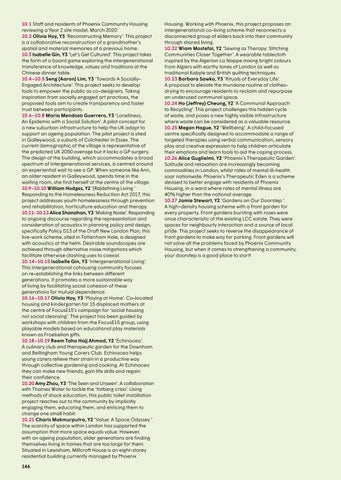10.1 Staff and residents of Phoenix Community Housing reviewing a Year 2 site model, March 2020. 10.2 Olivia Hoy, Y3 ‘Reconstructing Memory’. This project is a collaborative reconstruction of a grandmother’s spatial and material memories of a previous home. 10.3 Isabelle Gin, Y3 ‘Let’s Get Cultured’. This project takes the form of a board game exploring the intergenerational transference of knowledge, values and traditions at the Chinese dinner table. 10.4–10.5 Seng (Aaron) Lim, Y3 ‘Towards A SociallyEngaged Architecture’. This project seeks to develop tools to empower the public as co-designers. Taking inspiration from socially engaged art practices, the proposed tools aim to create transparency and foster trust between participants. 10.6–10.8 Maria Mendoza Guerrero, Y3 ‘Loneliness, An Epidemic with a Social Solution’. A pilot concept for a new suburban infrastructure to help the UK adapt to support an ageing population. The pilot project is sited in Galleywood, a suburb of Colchester in Essex. The current demographic of the village is representative of the predicted UK 2050 average but it lacks a GP surgery. The design of the building, which accommodates a broad spectrum of intergenerational services, is centred around an experiential wait to see a GP. When someone like Ann, an older resident in Galleywood, spends time in the waiting room, she find herself at the centre of the village. 10.9–10.10 William Hodges, Y2 ‘(Re)defining Living ’ Responding to the Homelessness Reduction Act 2017, this project addresses youth homelessness through prevention and rehabilitation, horticulture education and therapy. 10.11–10.13 Alice Shanahan, Y3 ‘Making Noise’. Responding to ongoing discourse regarding the representation and consideration of acoustics in planning policy and design, specifically Policy D13 of the Draft New London Plan, this live-work scheme, sited in Tottenham Hale, is designed with acoustics at the helm. Desirable soundscapes are achieved through alternative noise mitigations which facilitate otherwise clashing uses to coexist. 10.14–10.15 Isabelle Gin, Y3 ‘Intergenerational Living’. This intergenerational cohousing community focuses on re-establishing the links between different generations. It promotes a more sustainable way of living by facilitating social cohesion of these generations for mutual dependence. 10.16–10.17 Olivia Hoy, Y3 ‘Playing at Home’. Co-located housing and kindergarten for 15 displaced mothers at the centre of FocusE15’s campaign for ‘social housing not social cleansing’. The project has been guided by workshops with children from the FocusE15 group, using playable models based on educational play materials known as Froebelian gifts. 10.18–10.19 Reem Taha Hajj Ahmad, Y2 ‘Echinacea’. A culinary club and therapeutic garden for the Downham and Bellingham Young Carers Club. Echinacea helps young carers relieve their strain in a productive way through collective gardening and cooking. At Echinacea they can make new friends, gain life skills and regain their confidence. 10.20 Amy Zhou, Y3 ‘The Seen and Unseen’. A collaboration with Thames Water to tackle the ‘fatberg crisis’. Using methods of shock education, this public toilet installation project reaches out to the community by implicitly engaging them, educating them, and enticing them to change one small habit. 10.21 Charis Makmurputra, Y2 ‘Value: A Space Odyssey ’. The scarcity of space within London has supported the assumption that more space equals value. However, with an ageing population, older generations are finding themselves living in homes that are too large for them. Situated in Lewisham, Millcroft House is an eight-storey residential building currently managed by Phoenix 146
Housing. Working with Phoenix, this project proposes an intergenerational co-living scheme that reconnects a disconnected group of elders back into their community through shared living. 10.22 Wiam Mostefai, Y2 ‘Sewing as Therapy: Stitching Communities Closer Together’. A wearable tablecloth inspired by the Algerian La Nappe mixing bright colours from Algiers with earthy tones of London as well as traditional Kabyle and British quilting techniques. 10.23 Barbara Sawko, Y3 ‘Rituals of Everyday Life’. A proposal to elevate the mundane routine of clothesdrying to encourage residents to reclaim and repurpose an underused communal space. 10.24 Ho (Jeffrey) Cheung, Y2 ‘A Communal Approach to Recycling’. This project challenges this hidden cycle of waste, and poses a new highly visible infrastructure where waste can be considered as a valuable resource. 10.25 Megan Hague, Y2 ‘Wellbeing’. A child-focused centre specifically designed to accommodate a range of targeted therapies using verbal communication, sensory play and creative expression to help children articulate their emotions and learn tools to aid the coping process. 10.26 Alice Guglielmi, Y2 ‘Phoenix’s Therapeutic Garden’. Solitude and relaxation are increasingly becoming commodities in London, whilst rates of mental ill-health soar nationwide. Phoenix’s Therapeutic Eden is a scheme devised to better engage with residents of Phoenix Housing, in a ward where rates of mental illness are 40% higher than the national average. 10.27 Jamie Stewart, Y2 ‘Gardens on Our Doorstep ’. A high-density housing scheme with a front garden for every property. Front gardens bursting with roses were once characteristic of the existing LCC estate. They were spaces for neighbourly interaction and a source of local pride. This project seeks to reverse the disappearance of front gardens to make way for parking. Front gardens will not solve all the problems faced by Phoenix Community Housing, but when it comes to strengthening a community, your doorstep is a good place to start!
